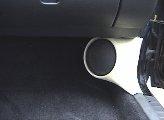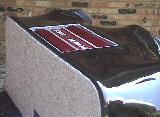Choosing Audio Equipment for the Marine Environment
We are fully into spring and for those areas that have more than one season (I'm looking at you San Diego) the boats are hitting the water. Some are simple fishing boats while other are full blown party vessels. But the majority are the traditional ski boats with room for a captain and a few friends. And what does any people hauler need but music. But there are many other factors that you need to consider with a marine system as compared to a car audio system.
Turn it up. What! Turn it up!
One of the things a marine system needs is power. Power makes volume and that's what you need to overcome the sound of the engine and the crashing of the waves as you're moving along the water. And not only while you move but also when you're stopped. Since most boats do not have an enclosed cabin like a vehicle does you lose a lot of volume to the open air. Adding a decent sized amplifier is practically a must to overcome these problems.
Element Resistant
In addition to lost volume the open cabin of a boat presents other problems for your sytem. There are three main elements that can attack your equipment. These are water, sun and salt. Now the salt is only a problem if you travel in saltwater or brackish bodies of water. But if you do that will be a major concern. Sun will beat down on everything not covered up so this means speakers and head units which aren't always as easily hidden like subwoofers and amplifiers can be. And of course water since we all know electronics and liquids don't get along too well.
Equipment Considerations
Let's take a look at the equipment you can install and see we need to look for.
Head Units - Just like in car audio this is the heart of the system. It's best to choose a head unit that is designed for the marine environment. They should be coated and sealed to prevent water and salt contamination. Since you'll probably be far away from traditional radio signals you might want to get a unit that can access satellite radio programming. With an open shot of the sky you shouldn't have any problems getting a signal anywhere you go. Also look for a unit with a remote control so you can access the features without accessing the unit itself.
Speakers - There are marine specific speakers which usually have a white plastic grill that is also designed to shed water from the speaker. The speaker itself should be plastic or metal (not paper) with a rubber surround so water, sun and salt will not easily eat away the cone.
Amplifiers - Like head units, there are marine specific amplifiers made. Look for models that have a sealed chassis (case of the amplifier) as well as corrosion resistant terminals for power and speaker connections. It's best if the ampliifier's circuit board is also dipped for even better protection against the elements.
Subwoofer(s) - The cautions that apply to main speakers also applies to subwoofers. Look for a non-paper cone and rubber surround. There are marine specific subwoofers made and like marine speakers they generally have a white grill and often a white basket.
Installation Considerations
Head Units - In addition to buying a marine specific unit you can and should install the head unit in a sealed enclosure. They also make clear/smoked plastic covers that go over the front of the unit. They flip up for access to the faceplate but with a remote control they can also be operated without lifting the cover. Generally the head unit is mounted in the captain's console and will not be directly exposed to sun or water. However use care when mounting the head unit. Use corrosion resistant mounting hardware and keep it out of water drip channels.
Speakers - Even if you purchase marine specific speakers you still want to mount them so they receive as little sun and water spray as possible. If the boat came with speaker holes from the factory you can probably use those without much worry. But if you need to cut your own holes use extreme caution. You obviously don't want to have a hull breech due to a poorly placed mounting hole or mounting screw. Make absolutely certain you know what you're cutting into and what is behind it. And make sure you know that you have enough depth for the speaker before hacking a hole into the boat.
Once you have the hole make sure to use corrosion resistant mounting hardware (i.e. stainless steel). And for the copper speaker wiring make sure you do not leave any bare copper wire exposed. It corrodes easily in the marine environment. Tin the leads with solder and heatshrink whenever possible.
Amplifiers - The same basic mounting cautions for speakers also apply to amplifiers. Keep the amplifiers out of water channels and mount them vertically whenever possible. This let's any water that might splash them drip off. If they were mounted horizontally in a place such as a cargo well they could be in standing water which would cause damage. Enclosed spaces can also cause amplifiers to overheat so make sure they get enough ventilation just as you would in a car audio installation.
And just like speakers be sure to use corrosion resistant mounting hardware. Tin with solder and seal any bare copper wiring to prevent corrosion. And for the grounding connection you will need to either find a factory ground strap or consult the boat's manufacturer for guidance. Fiberglass tends to be a poor conductor it turns out :)
Subwoofer(s) - In addition to the mounting considerations you would use with speakers, subwoofers also need an enclosure. The enclosure both provides the necessary airspace for the woofer but also protects it from the elements. The best way to prevent the back of the subwoofer from this damage is to make sure the basket is fully enclosed. This means either a simple sealed subwoofer enclosure or a single port (front) bandpass enclosure. Vented enclosures can allow water and salt into the cabinet which can corrode the subwoofer from the inside. If you must use a vented enclosure consider a passive radiator design instead. This keeps the enclosure sealed.
In addition to being sealed the enclosure itself must also be water resistant. This means that a straight MDF box is out. And any wood you do use (such as a speaker mounting ring) must be coated to prevent any water contamination. A good choice here is a fiberglass enclosure. It is both lightweight and waterproof. If it's good enough for the boat it's good enough for your subwoofer. Plus it can be molded into an odd shaped cavity you may have available. Just be sure to secure it so it doesn't bounce around every time you hit a wave.
Conclusion
While no means a fully comprehensive guide to marine audio equipment and installation I hope this article gives you an idea of some of the challenges in a marine audio system. If there is anything else you would like to see added to the article please let me know. You can send an email using the Contact link at the bottom right of every page.

You should check out Fiberglass Fabrication I. It covers an introduction to fiberglass work with sections on kick panel speakers pods, MDF enclosures with curved fiberglass baffles and spare tire subwoofer enclosures. Click here.

For those with fiberglass experience or who want to create more advanced fiberglass projects Fiberglass Fabrication II has just been released. It shows you how to create vehicle molded subwoofer enclosures, multiple woofer/amp rack combinations and custom door panels. Click here.
Both DVDs are available together at a special price.
Back to the Newsletter Archives Index